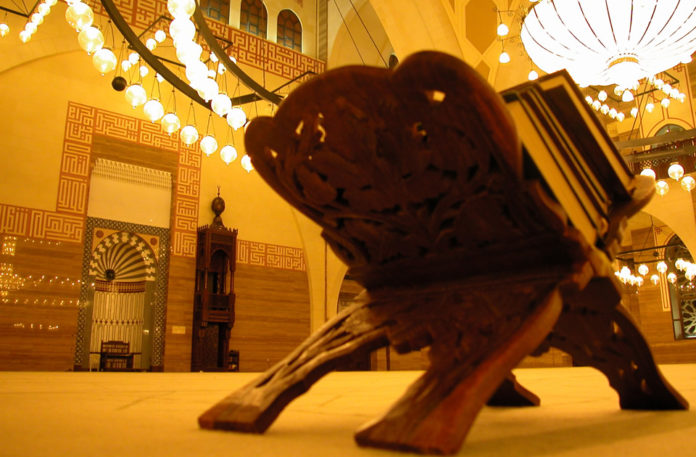Malik was born and lived his whole life in Medina and saw the traces of the Companions and Followers and the grave of the Prophet, salallahu alayhi wasalam and all the great places there. He felt an enormous esteem for Madina and all it contained which marked his life from his earliest childhood. He knew it to be the cradle of knowledge, the fountain of light and the spring of gnosis. He maintained this deep-rooted respect until his death and it had a profound impact on his thought, his fiqh and his life in general. He never rode in Medina and he gave great importance to the practice of its people in his ijtihad. Indeed, the principle of the ‘Practice of the People of Medina’ was one of the foundations of his legal method, as we will show.
Malik grew up in a household which was engaged in the science of Traditions and hadith. His family was interested in the knowledge of the reports and traditions of the Companions and their fatwas. His grandfather, Malik ibn Abi ‘Amir, was one of the great men of knowledge of the tabi’un. He related from many Companions. It is clear, however, that Anas ibn Malik, Maliks father, was not greatly concerned with hadith since it is not known that Malik related anything from him, although Malik’s grandfather and uncles were. His family was well-known for their devotion to knowledge. Malik was originally known as ‘the brother of an-Nadr’, a brother of his who was esteemed for his knowledge. Then his own desire to seek knowledge grew to such an extent that people began to say, ‘an-Nadr, the brother of Malik.’
After memorising the Qur’an he devoted himself to memorising hadith, which was much encouraged in the environment of Medina. Malik went to the assemblies of scholars to write down what they taught and study it. He told his mother that he wanted to go and study and she dressed him in his best clothes and turban and then said,
| “Go and write now.” |
She said,
| “Go to Rabi’a and learn his knowledge before learning his adab.” |
Malik devoted himself to knowledge from an early age and sought it out from the people of knowledge in Medina. He confined himself to two areas of knowledge: hadith and fiqh. He did not like to argue about the reports of the various sects regarding matters about which people become confused and disagree. That was not due to any ignorance of their positions but was based on knowledge and clear evidence because he saw that delving into such things had no benefit.
We mentioned these anecdotes about Malik’s quest for hadiths and what has been said about his shaykhs in order to bring out three points. Firstly, at that time knowledge was taken by learning directly from the mouths of men and not from books in which knowledge was recorded. This is why the memory of students was so sharp: they were entirely dependent on it and were eager not to lose anything they heard. Malik kept track of the number of hadiths he learned by tying knots in a length of thread. If he forgot a hadith, he would return to hear it again. No reproach or rebuke would stop him, but even so he would only miss the odd one.
The second thing we learn is that scholars had begun to record their knowledge in writing, even if they did not rely on what was written. Ibn Shihab encouraged his students to write down what they heard, out of fear that they might forget it. Malik went to him with slates in hand on which he wrote down what he heard. That did not prevent him from memorising what he wrote. So when Ibn Shihab took away the slates he could repeat what was on them.
Thirdly, we gather from these extracts that Malik was tirelessly devoted to seeking knowledge and applied himself to it with an earnestness, energy and patience rarely emulated in the history of Islam. Undeterred by intense heat, he would leave his home and wait for the time when scholars left their houses for the mosque, and not even the irascibility of some of them prevented him from learning from them. He endured criticism for that at times but he kept at it until he managed to achieve his aim.
***
We should at this point elaborate on the different branches of knowledge that Malik studied in his pursuit of learning. He sought knowledge in four areas which are part and parcel of the formation of the complete scholar and faqih who knows the sources properly, who is able to derive rulings from them correctly, who is in touch with the spirit of his time and has true understanding of what is happening around him, and has the ability to disseminate among people the knowledges which he thinks are beneficial for them.
Firstly he learned how to refute adherents of deviant sects and how to resolve people’s disagreements and clarify their disputes in respect of fiqh and other matters. He studied that with Ibn Hurmuz, as he himself said. He took from him much knowledge which he did not spread publicly. But when there was an occasion where it was necessary to impart it, he did so.
Secondly he learned the fatwas of the Companions from the Tabi’un and the Tabi’i’t-Tabi’in. He learned ‘Umar’s fatwas and those of Ibn Umar, ‘A’isha and other Companions. He learned the fatwas of Ibn al-Musayyab and other great Tabi’un. Their fatwas are the source of much of Maliki fiqh.
Thirdly he learned fiqh ar-ra’y (understanding by mental perception) from Rabi’a ibn ‘Abdir-Rahman who was known as Rabi’a ar-Ra’y. It is evident that the method he learned from Rabi’a was not the same as analogy. Its basis was harmonisation of different texts with the best interests of people and how they could best be benefited. That is why, according to al-Madarik, “Malik was asked whether they used to use analogy in the assembly of Rabi’a and discuss a lot with one another. He said, ‘No, by Allah.'” From this we can see that Malik did not understand fiqh ar-ra’y as meaning opinion in which there is a lot of analogy and analysis because that might have led to involvement in the kind of hypothetical fiqh which was so common in Iraq and which resulted from the excessive use of analogy. Rabi’a’s basic principle was the best interests of the people.
Fourthly he learned the hadiths of the Messenger, may Allah bless him and grant him peace; he sought out all who transmitted the Messengers words and selected the most reliable among them. He was given great insight into men’s understanding and the power of their intellects. It is reported that he said,
| “This knowledge is vital to the Deen, so look to the one from whom you take it. I have met seventy people who said, ‘The Messenger of Allah, may Allah bless him and grant him peace, said’ within these pillars,” |
and he pointed to the mosque,
| “and I did not take anything from them. Had any of them been entrusted with a treasure, they would have proved trustworthy, but they were not worthy to undertake this business.” |
After Malik completed his studies he took a place in the mosque of the Prophet to teach and give fatwas. There is no doubt that he used to sit in the place of those Tabi’un and their followers to whom people came from east and west. This must mean that he had both great knowledge and also the respect and esteem of the people and that made him the focus of students of fiqh and those who sought fatwas on many different subjects. This is why he said to clarify his position when he set up to teach and give fatwa: “No one who desires to sit in the mosque to teach hadith and fatwa can do so until he has consulted people of soundness and excellence and the people in charge of the mosque. Only when they consider him worthy of it may he sit there. I did not sit until seventy shaykhs of the people of knowledge had testified that I was ready to do so.”
***
Malik lived surrounded by the traces of the Tabi’un and Companions, and he learned the fatwas of the Companions from the Tabi’un and singled out those whose opinions were best. He investigated the reports of ‘Umar and Ibn Mas’ud and other fuqaha’ of the Companions, studying their cases and rulings. He was eager to learn precedents in order to follow what had gone before and not to innovate. He thought that the actions, weights, measures, waqfs and reports of the people of Medina were sufficient to illuminate any faqih who followed their guidance and borrowed from their light.
***
It is reported in ad-Dibaj that
| “Malik used to come to the mosque and attend the prayers, Jumu’ah, and funerals, visit the sick, and sit in the mosque; and his Companions would join him there. Then he ceased to sit in the mosque. He did not attend funerals but would go to his companions and console them. Then he ceased doing even those things. He did not attend the prayers in the mosque or go to Jumu’ah or go to console anyone. But he continued to see people until he died.” |
Most people agree that he died in 179 AH, on the night of the 14th of Rabi’ ath-Thani, at well over eighty years of age. Imam Malik died in the year 795 AD at Medina and was buried in the famous al-Baqi cemetery in the Medina with the noble Prophet Companions.
Imam Malik’s followers and disciples developed the Fiqh science based on his books which came to be known as the Maliki Madhhab (approach). Most of the people who follow the Maliki Madhab are found in North and West Africa, – Tunis, Algeria, Morocco and Egypt.
Footnote
Taken from islamawareness.net
(NOTE: If you want to build a strong and powerful relationship with Allah, check out Islamia TV, where you can watch Islamic speakers from across the globe deliver inspiring and motivational courses. Learn more at www.islamia.tv.)











![[Video] Fathers: 3 Tips to Build a Strong Bond with Your Kids](https://islaam.net/wp-content/uploads/2016/12/15320029_1208001002581026_5522108257843281920_n-2-218x150.jpg)









